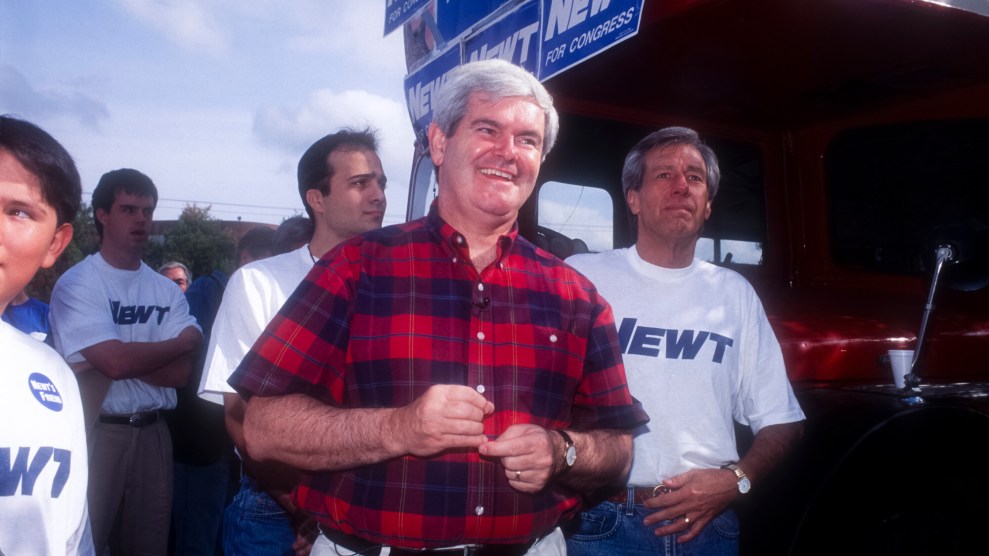Now that John McCain has, for the zillionth time, pooh-poohed the intriguing but improbable notion of a Kerry-McCain ticket, let’s hope that attention shifts to the more viable (and Democratic) contenders for the vice-presidency, like Iowa Governor Tom Vilsack.
Unlike, John Edwards and Dick Gephardt, Vilsack didn’t run for president and isn’t a household name. In a recent AP poll, just 4 percent picked Vilsack as Kerry’s running mate, compared with 36 percent favoring Edwards, 19 percent Gephardt, and 18 percent Wesley K. Clark.
Nevertheless, Vilsack has his backers. Al From of the Democratic Leadership Council—the centrist heart of the Democratic party, out of whose ranks Bill Clinton emerged in the 1990s—has said that Vilsack was “very much a favorite” of his. New Mexico governor Bill Richardson—whose own name is often floated as a potential veep—endorsed Vilsack as well. Even Vilsack’s opponents, like Rep. Christopher Rants, the Republican speaker of the state’s legislature, concede the governor’s strengths: “He’s very bright, he’s very articulate. It doesn’t make him right on the issues, but it makes him a worthy adversary. … He gives a good stump speech.”
So what else what makes Governor Vilsack so attractive? For a start, he hails from a battleground state. Iowa, which Al Gore won with less than one percent of the vote in 2000 and where Kerry has a narrow lead, will be one of the most closely contested states in 2004 as well. (Admittedly, Iowa offers only seven electoral votes compared with Ohio’s twenty and Missouri’s eleven, but every vote counts). Last month, Slate, in its overview of potential veeps, put Vilsack in the category of candidates who “Don’t Mean a Thing If They Ain’t From a Swing”:
“As a Catholic with a moderate profile on social issues, as well as a compelling biography, Iowa Gov. Tom Vilsack could shore up Kerry with blue-collar voters, but is otherwise humdrum. Still, one bankable state could make the difference. And for the same egotistical reasons Kerry may spurn an Edwards, a reliable dullard could be just what he wants.”
Some within Kerry’s campaign fear that Edwards, who ran an effective positive campaign during the primary and was even dubbed a sex symbol, may steal too much of the limelight away from Kerry. Though Vilsack, like Edwards, has been campaigning for Kerry, Vilsack’s team has been much more circumspect about the veep speculations. During the primaries, Vilsack wife Christie’s endorsement of Kerry, was seen as a factor in helping him carry the state at a time when Howard Dean was still seen as the favorite (Vilsack himself didn’t endorse anyone).
Vilsack is Iowa’s first Democratic governor in over 30 years and will be its third-longest serving when he finishes his second term, having said he won’t seek re-election. Vilsack is credited with creating incentives for businesses to relocate to Iowa through his Iowa Values Fund; the state’s unemployment is below 4 percent, compared with 5.6 percent nationally; and he has made education a priority, with reduced class sizes to prove it.
Vilsack also has a compelling life story. An orphan, who suffered physical abuse from his adopted alcoholic mother in Pittsburgh, Pennsylvania, he went on to become a successful trial lawyer, mayor of the Iowan town Mt. Pleasant, and a state senator, before being elected governor. Kerry’s campaign may see Vilsack as providing the “common touch” its candidate lacks. American Prospect‘s Terence Samuel also notes that Vilsack can help Kerry pick up a few of Iowa’s neighbors and has the “attack-dog factor, which is needed in a veep.” Samuel illustrates the point by citing Vilsack on the attack:
“This is an administration that seems to have a tin ear to the pleas of the unemployed, by failing to extend unemployment benefits when we have chronically unemployed people; does not have an aggressive manufacturing policy or program to restart and rebuild the manufacturing economy in this country, or replace it with something better. This is an administration that does not adequately fund its own education initiative, which means that children will, in fact, be left behind. This is an administration that provides a prescription-drug bill that really provides more assistance for pharmaceutical companies than it does senior citizens.”
On the other hand, in a campaign dominated by war in Iraq and national security, Vilsack’s lack of foreign policy experience will no doubt count against him. He is also vulnerable on domestic policy. Iowa had $50 million budget deficit in 2003. Vilsack’s plan to recruit foreign workers to the state and proposals to raise taxes on cigarettes and some services will also make good targets for the Republicans. David Hogberg, writing in the National Review, has pinned Iowa’s financial woes not on shortfall in revenue often pointed out by Vilsack, but on governor’s spending programs, calling the Values Fund, a form of “corporate welfare.” Unsurprisingly, Hogberg concludes that Vilsack would be a liability for Kerry, who will “have to spend much of the general-election campaign fending off charges that he is a tax-and-spend Massachusetts liberal. He won’t need a tax-and-spend Midwestern liberal as his running mate.” The fact that Vilsack singed an executing order prohibiting discrimination based on sexual orientation—an order later overturned by the state’s legislature—will also be used as armor against him by social conservatives. Vilsack’s favorability ratings have slid to below 50 percent, and some Democrats are having doubts about whether he would be able to deliver the state’s electoral votes.
But the Kerry campaign is taking a long, hard look at Vilsack, as evidenced by recent requests for the newspaper columns he wrote as mayor of Mt. Pleasant. Whether anything juicy—or veep-worthy—is to be found in Vilsack’s “Mayor’s Moments” remains to be seen.















